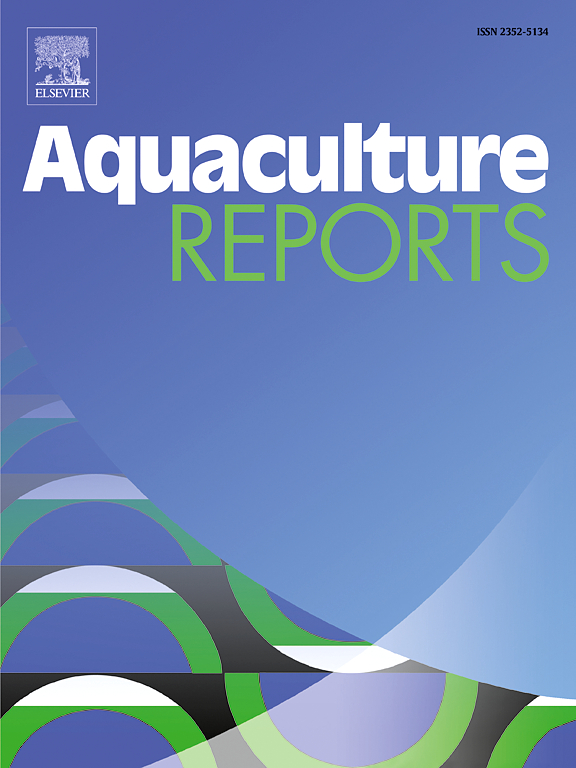Identification of sex determination region and candidate genes in blotched snakehead (Channa maculata) through genome-wide association studies and transcriptome analysis
IF 3.2
2区 农林科学
Q1 FISHERIES
引用次数: 0
Abstract
The blotched snakehead (Channa maculata) is an economically significant freshwater species in China, exhibiting pronounced sexual size dimorphism, with males displaying faster growth rates and larger body sizes. Monosex farming has the potential to significantly substantially enhance aquaculture efficiency for this species. In this study, we conducted whole-genome resequencing of 45 female and 50 male blotched snakehead individuals. Genome-wide association analysis (GWAS) was performed based on genome-wide SNPs and InDels, and combined with fixation index (Fst) analysis between male and female groups, which identified a candidate sex-determining region located on Chr.02: 34,288,075–34,351,554 (63.479 kb). Linkage disequilibrium analysis revealed that the sex-determining region has formed a haplotype block with a state of linkage disequilibrium. Within this region, we identified six InDels larger than 15 bp and developed two sex-specific markers capable of accurately identifying the genetic sex of blotched snakehead. Additionally, we performed transcriptome analyses of male and female gonads at 120, 150, and 180 days post-fertilization (dpf). Combined with the GWAS results, we identified candidate sex-determining genes, including five male-biased genes (EVM0022796, ITGB1BP1, RSAD2, CMPK2, and KIDINS220) and two female-biased genes (Sox11 and DNAJC30). This study enhances our understanding of the genetic basis of sex determination in blotched snakehead, providing novel insights into its genetic mechanisms. Our findings establish a solid scientific foundation for applications in monosex breeding and marker-assisted selection breeding programs in this species.
通过全基因组关联研究和转录组分析鉴定斑点蛇头(Channa maculata)性别决定区和候选基因
斑点蛇头(Channa maculata)是中国一种具有重要经济意义的淡水物种,具有明显的性别大小二态性,雄性蛇头生长速度更快,体型更大。单性养殖有可能显著提高该物种的养殖效率。在这项研究中,我们对45条雌性和50条雄性斑点蛇头进行了全基因组重测序。基于全基因组snp和InDels进行全基因组关联分析(GWAS),并结合雄性和雌性群体之间的固定指数(Fst)分析,确定了位于Chr.02: 34,288,075-34,351,554(63.479 kb)的候选性别决定区域。连锁不平衡分析表明,性别决定区形成了一个连锁不平衡状态的单倍型区。在这一区域内,我们鉴定出了6个大于15 bp的indel,并开发了两个能够准确识别斑点蛇头遗传性别的性别特异性标记。此外,我们在受精后120、150和180天(dpf)对雄性和雌性性腺进行转录组分析。结合GWAS结果,我们确定了候选的性别决定基因,包括5个男性偏向基因(EVM0022796、ITGB1BP1、RSAD2、CMPK2和KIDINS220)和2个女性偏向基因(Sox11和DNAJC30)。本研究增强了我们对斑点蛇头性别决定的遗传基础的理解,为其遗传机制提供了新的见解。本研究结果为该物种的单性育种和标记辅助选择育种奠定了坚实的科学基础。
本文章由计算机程序翻译,如有差异,请以英文原文为准。
求助全文
约1分钟内获得全文
求助全文
来源期刊

Aquaculture Reports
Agricultural and Biological Sciences-Animal Science and Zoology
CiteScore
5.90
自引率
8.10%
发文量
469
审稿时长
77 days
期刊介绍:
Aquaculture Reports will publish original research papers and reviews documenting outstanding science with a regional context and focus, answering the need for high quality information on novel species, systems and regions in emerging areas of aquaculture research and development, such as integrated multi-trophic aquaculture, urban aquaculture, ornamental, unfed aquaculture, offshore aquaculture and others. Papers having industry research as priority and encompassing product development research or current industry practice are encouraged.
 求助内容:
求助内容: 应助结果提醒方式:
应助结果提醒方式:


